The Best Food Distribution Software
With decades of experience helping businesses find software, we wrote this guide to showcase the best food distribution ERP systems that offer inventory control, supply chain management, and CRM functionality.
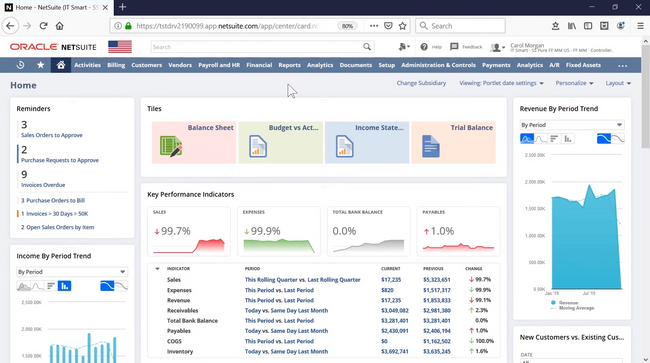
- Hundreds of third-party add-ons available
- Feature sets for multiple industries
- Highly customizable
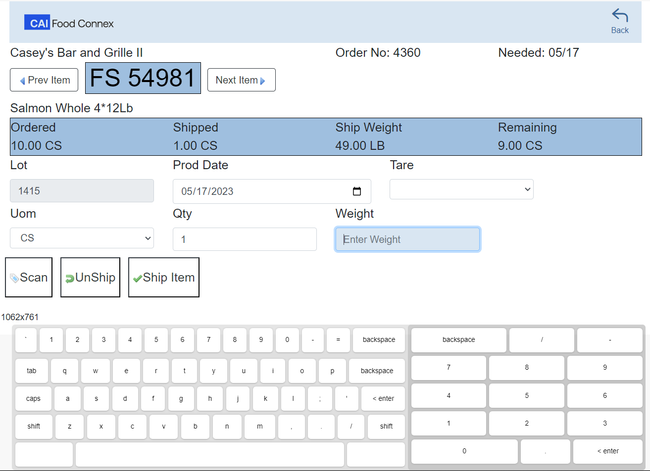
- Managed IT Services
- Real-Time Inventory
- Ability to track lots and attributes
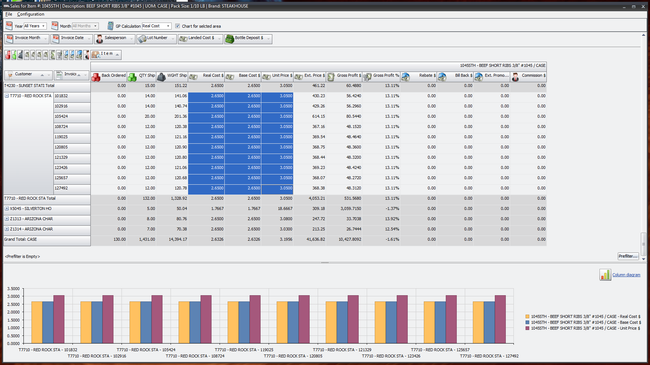
- Offers catchweight tracking, inventory management, salesperson commissions
- Responsive and knowledgeable customer support
- Offers proof of delivery functionality
We ranked these systems based on how well they support different food distribution sectors, including consumer packaged, specialty, produce, and meat. Discover the top qualities of each software and why it best suits your distribution needs.
- NetSuite: Best for Consumer Packaged Goods
- Food Connex: Best for Meat
- Entrée: Best for Produce
- Acctivate: Best for Frozen
- WholesaleWare: Best for Wholesalers
- Sage X3: Best for Specialty
- Maritech: Best for Seafood
- Northstar WMS: Best WMS
- Deacom: Best for Dairy
NetSuite - Best for Consumer Packaged Goods
NetSuite’s demand planning tool can help you predict future inventory needs and stay ahead of constantly shifting demand patterns. It generates demand forecasts using previous sales data, seasonal patterns, and real-time market trends. This goes beyond basic inventory management, helping you minimize stockouts and overstocks and ensure optimal inventory levels across numerous locations.
Through the demand planning tool, you can choose between four projection methods to improve forecast accuracy:
- Linear Regression: This method works best for items with steady, predictable growth, such as snack lines that have shown consistent sales growth year after year.
- Moving Average: Best for consistent essentials that don’t have seasonal fluctuations and are relatively stable in demand, such as pantry items. This shows a smooth forecast, with hardly any fluctuations in stock levels.
- Seasonal Average: Ideal for products with clear demand patterns, such as holiday sweets that are popular only during a specific time of the year. This will help you prepare for spikes and minimize overstocks after the holiday season ends.
- Sales Forecast: Best for new product launches when aligning your inventory with projected promotional performance.
Inaccurate planning can lead to costly markdowns or missed orders. NetSuite’s demand planning tool lets you configure additional parameters on its “calculate item demand plans” screen. You can select your projection interval (weekly or monthly) and set your projection and historical analysis duration. If there isn’t enough historical data for an item, you can select the alternate source item from the existing data master, ensuring your demand plan is as accurate as possible.
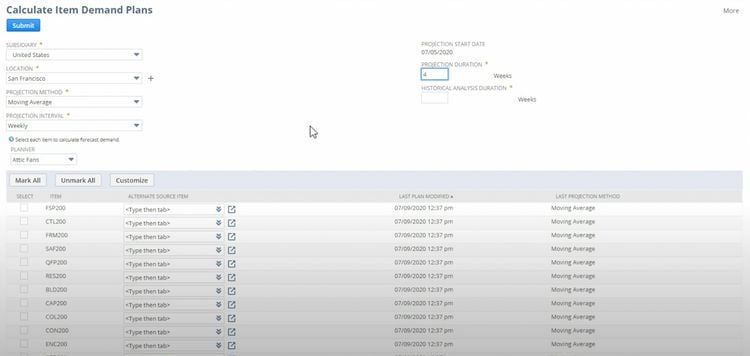
The demand planning tool seamlessly integrates with NetSuite’s other modules, including financials and order management, providing real-time visibility into how demand changes impact your margins. The tool’s integration means NetSuite can trigger purchase orders automatically for replenishment, ensuring your stock stays ahead of demand fluctuations. It can also prioritize orders and allocate stock based on inventory availability.
To learn more about NetSuite, read our full review.
Food Connex - Best for Meat
Food Connex offers strong traceability features that help track specific cuts of meat throughout the supply chain. Once meat comes in, each cut is assigned a unique barcode or RFID tag. This label has detailed information about the product’s source, processing date, and relevant certifications.
The barcode is scanned as the meat moves through various stages of processing and distribution, allowing you to capture data all the way from the farm to the customer’s table. This quick traceability allows you to identify and isolate contaminated products quickly and easily. You can also monitor handling and storage conditions to ensure that quality standards are maintained.
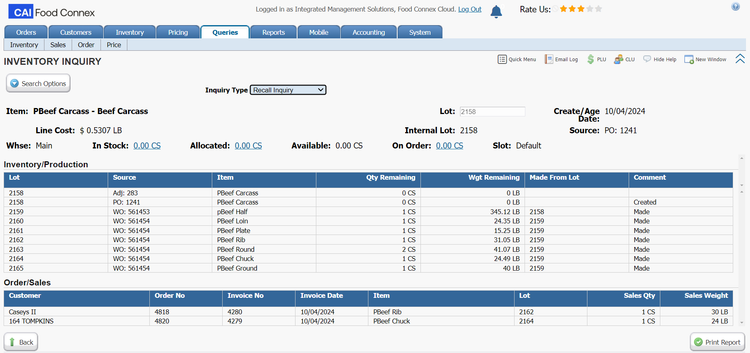
Food Connex is specifically designed for food and beverage distributors and is particularly well-suited if you use QuickBooks. Prices start around $10,000-$14,000/year, depending on your company size, requirements, and implementation complexity.
For more information, read our full review of Food Connex.
Entrée - Best for Produce
NECS Entrée’s inventory module with lot-level traceability is crucial for produce distributors. This level of visibility helps you ensure food safety while keeping you ready for any recall events. The module also has country-of-origin labeling, allowing you to comply with FSMA regulations. And if you process your own products, Entrée has you covered, letting you track the entire process from the field to shipment.
Additionally, Entrée’s inventory dashboard lets you see key details for every item. Fields like temperature zone and warehouse location are easily viewable to ensure proper storage at a glance. The system also lets you assign different units of measure (UOM) like cases, pounds, and bushels to support different fruits and vegetables. Plus, it even has catch-weight and case-breaking support to measure products with highly variable weights accurately.
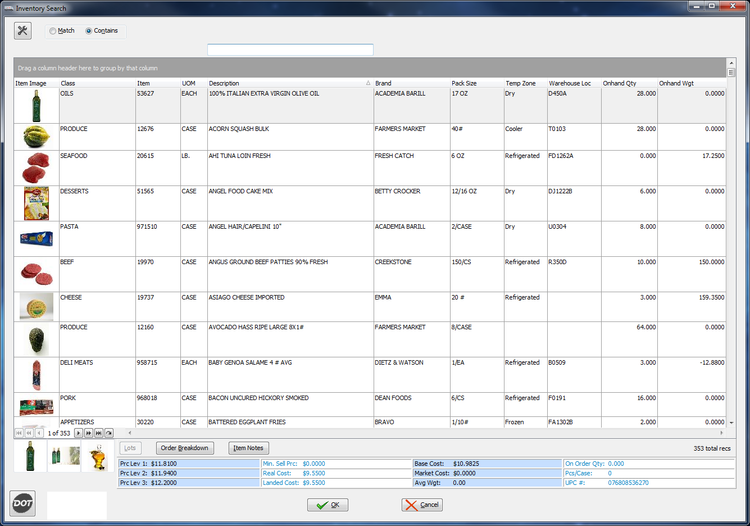
Beyond produce, Entrée supports food distributors of all types, including sectors like meat, seafood, and packaged goods. It’s best suited for companies with annual revenue of $1 million to $200 million. Unfortunately, pricing requires a custom quote.
See our full Entrée product profile for more information.
Acctivate - Best for Frozen
Acctivate offers several lot tracking features designed for frozen food distributors to help ensure product safety and compliance. The software lets you easily track and trace unlimited products using lot numbers through the supply chain, including forward and backward lot tracing, which can help you quickly identify and isolate any quality or safety issues, allowing for prompt corrective actions.
Each lot allows you to assign various attributes, including:
- Expiration Dates: Allows you to manage time-sensitive products to help minimize waste. You can set alerts to prioritize sales of older stock, ensuring you adhere to first-expiry, first-out picking (FIFO) practices and avoid issues like freezer burn or spoilage.
- Supplier and Vendor Information: If there is a quality issue or recall, you can trace products back to their source, making it easier to identify if improper handling occurred before reaching your facility
- Storage Locations: Having designated freezer locations for each item simplifies locating products for quality checks, restocking, and shipping. Proper organization helps reduce the risk of temperature fluctuations.
- Number On Hand: Provides real-time visibility into inventory levels across different storage zones, like deep freeze versus regular freeze. This can help you plan quality audits and inspections and avoid costly stockouts.
- Unit Cost and Value: Tracks unit costs for frozen goods, helping ensure your pricing strategy accounts for fluctuating operational expenses.
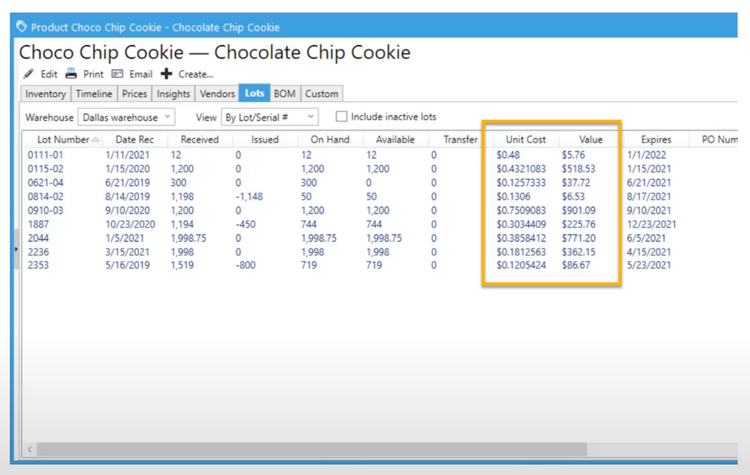
When you receive inventory and enter a new product in Acctivate, you must enter a lot for every transaction. Each lot number captures key data, such as actual cost, letting you monitor cost changes over time and see if storage or handling fees have increased. The system also provides a drop-down list of adjustments to choose a lot number available in specific freezer locations, ensuring accurate on-hand quantities, which helps reduce overstock and prevent waste.
You’ll also need to enter an expiration date as you receive a new product. This is important for frozen food distributors, letting you prioritize which lots should be sold first to minimize waste. If you haven’t sold a specific product by its best-buy date, Acctivate lets you identify and remove expired lot numbers from inventory, ensuring compliance with safety regulations.
Acctivate is specifically designed as an inventory management software, providing real-time visibility into stock levels. The system syncs directly with QuickBooks, making it a good fit if you use it as your accounting software. However, if you’re not a QuickBooks user, you’ll need to consider a different option.
For more information on Acctivate, read our full review.
WholesaleWare - Best for Wholesalers
WholesaleWare is a great option for wholesale food distributors who require complete control of their supply chain. It features full lot and batch traceability across your receiving, storage, picking, and shipping processes. You can sort all orders by different parameters, like vendor or lot number, to see the entire history for audits or potential recalls. This enables compliance with FSMA 204, where rapid 24-hour traceability reporting is essential.
Additionally, WholesaleWare offers strong warehouse management capabilities to help you organize and sort your inventory. This includes location tagging, allowing your team to quickly locate every pallet in your facility. This means less time searching for stock, resulting in faster order fulfillment or removing spoiled product. The system easily connects with barcode scanning and label printing technology, like Zebra, for simple receiving. This is crucial for wholesalers, who frequently fulfill large bulk orders and need to move fast.
WholesaleWare also includes modules for HR, selling, and logistics. For accounting, though, you’ll need to integrate either QuickBooks or NetSuite. It’s great for growing small to midsize wholesalers that want a more flexible system as opposed to a full ERP. Pricing starts at $15,000/year, but you’ll need a custom quote for exact costs.
Read more on our WholesaleWare product page.
Sage X3 - Best for Specialty
Avoiding cross-contamination and ensuring regulatory compliance with safety regulations like the Food Allergen Labeling and Consumer Protection Act is critical in specialty food distribution. Sage X3 offers essential functionalities for tracking allergens and ingredients, helping you maintain accurate product labeling and comply with regulations. This feature can be particularly beneficial if you focus on niche markets like gluten-free, dairy-free, organic, or allergy-sensitive products.
The software’s food allergen grid lets you assign multiple allergens to each product based on its ingredients, providing an easy-to-navigate list for tracking and management. This grid integrates with the ingredient component list, so you can view and update allergen information at every level, ensuring accurate labeling and reducing manual data entry.
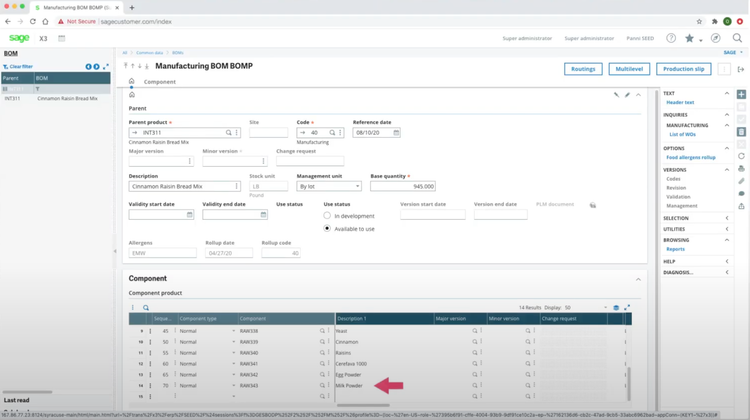
The system has a food allergens rollup function that automatically updates allergen information for manufactured products. This feature will clear any previously saved allergens and build its own comprehensive list based on all components in the parent product. This ensures that your allergen records are always current, reflecting the most accurate information for the final allergens list, the BOM code, and the date the list was last modified.
Additionally, if there ever is an allergen-related recall, Sage X3 allows you to isolate affected products quickly through its advanced traceability and recall management tools. The software can trace the origin and destination of any product that contains allergens, identify where it was shipped, and block it from being sold until the issue is resolved. This level of control can safeguard consumer health while protecting your company’s reputation and compliance standing.
Read more about Sage X3 in our full review.
Maritech - Best for Seafood
You depend on fast transportation methods, like refrigerated trucks or air freight, to keep your products fresh upon delivery. However, these methods consume more energy and produce higher CO2 emissions, leading to a larger environmental footprint. Maritech’s sustainability reporting feature can automate documentation and monitor real-time data on your environmental impact. Demonstrating your efforts to reduce emissions can help meet sustainability standards, attract environmentally conscious customers, and secure long-term business relationships.
As demand for sustainability certifications like those from the Marine Stewardship Council and Aquaculture Stewardship Council grows, tracking emissions and other environmental metrics has become essential. The emissions dashboard makes it easier to comply with certification requirements. This tool enables you to access information on emissions from various transport modes, like road, air, and sea, allowing you to assess CO2 emissions and their intensity based on factors such as country, customer, origin, or route.
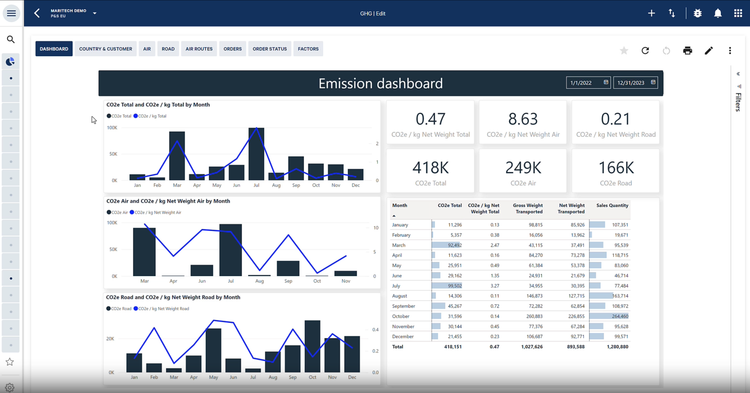
You can also see the total emissions per order and the exact emissions from harvesting and production. Using these sustainability reporting tools, you can reduce your carbon footprint and save costs by optimizing energy use and transportation.
This feature allows you to access current and past sustainability data, providing valuable trend analysis to assess your progress over time. The system also ensures compliance with the EU Taxonomy for Sustainable Activities, reinforcing your organization’s commitment to sustainability in all aspects of your supply chain.
Northstar WMS - Best WMS
NorthStar WMS offers strong inventory control features for mid to large-size food distribution companies managing large warehouses. These include:
- Lot Control: Enables traceability by tracking products by batch or lot numbers.
- Allergen Control: Manages products containing allergens within your warehouse to prevent cross-contamination and ensure compliance with regulations.
- Temperature Control: Great for meat or produce distributors, this monitors temperature-sensitive products in the warehouse to maintain product quality and minimize spoilage.
- Expiration Date Control: Tracks the shelf life of perishable goods and schedules inventory rotations to reduce waste and improve turnover.
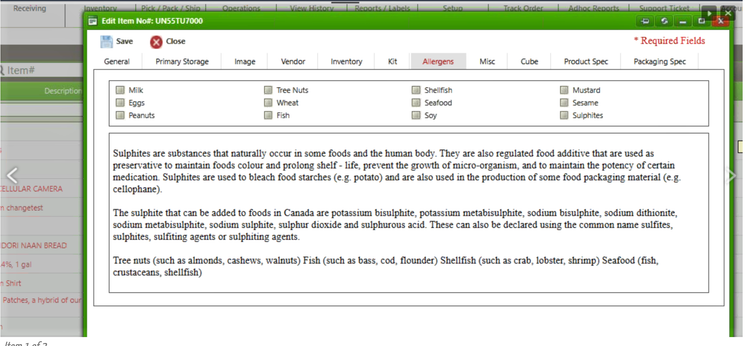
Integrating a WMS with your ERP or accounting system can have a huge impact on upholding safety standards. The real-time data sync leads to better inventory visibility, as you can track levels and locations across both systems. This helps you improve replenishment, minimize stockouts, and ensure end-to-end traceability. And because NorthStar WMS has multi-warehouse support, this can be accomplished across every location.
Read our full NorthStar WMS review to learn more.
Deacom - Best for Dairy
Deacom’s lot traceability and recall management help dairy distributors adhere to strict USDA and FDA oversight, especially when short shelf lives and allergen sensitivities are involved. It allows you to drill back to the exact supplier and forward to every retail chain or school cafeteria that might have received a contaminated product.
You start on the inventory reporting screen and navigate to the lot tracking view; from there, you can search by item, supplier, or code to click into a specific lot. This record will show you all the details you need, from expiration date to quality specs, so a planner or CSR can confirm what was received. You can either drill into the purchase order or jump forward into intermediate and finished goods and shipments.
Allocation and fulfillment behavior builds on that through FEFO. Deacom auto-prioritizes lots nearing expiration, so the system uses or ships the right stock first without manual re-sorting. This helps reduce spoilage, and if a quality issue emerges, this same lot screen becomes the control center for a recall. Your team can immediately quarantine the remaining on-hand quantity, list the customers who received those items, and trigger an alert with the built-in send-email function.
Deacom captures the entire chain, from raw material to delivery, assembling a record set that satisfies FSMA Section 204’s 24-hour traceability standard. While Deacom starts at $5,000 for the full-scale ERP, smaller distributors can turn to the Essentials package at $500/month.
Read our full Deacom review.
Other Systems We Like
- SOS Inventory is a good option for small to medium-sized distributors. The system provides lot tracking, barcode scanning, and expiration date monitoring, and supports FIFO accounting. It is also highly affordable and integrates with QuickBooks Online.
What is Food Distribution Software?
Food distribution software is a system designed specifically for companies that distribute perishable goods, ensuring the safe and efficient handling of products. It includes basic functions such as inventory management, order management, lot tracking, transportation management, and expiration date management.
Depending on the software type and your food sector, the system may offer additional features like route optimization, catch weight measurement, and temperature control. These functionalities are especially important for sectors like seafood, dairy, meat, fresh produce, and frozen goods, where maintaining quality and adhering to safety regulations are essential.
Key Features and Benefits
- Inventory Management: Tracks inventory in real-time to ensure timely delivery and reduce food waste.
- Lot Tracking: Trace products back to their origin, helping your business comply with specific food regulations and identify the source of contamination. This way, you can stop products from being delivered if there is a recall.
- Demand Planning and Forecasting: By accurately forecasting demand, you can avoid overstocking your products, reducing food spoilage and waste.
- Expiration Date Management: Implements FIFO to ensure that products don’t expire and go to waste.
- Allergen Management: Track and manage allergen information to prevent contamination and ensure proper labeling.
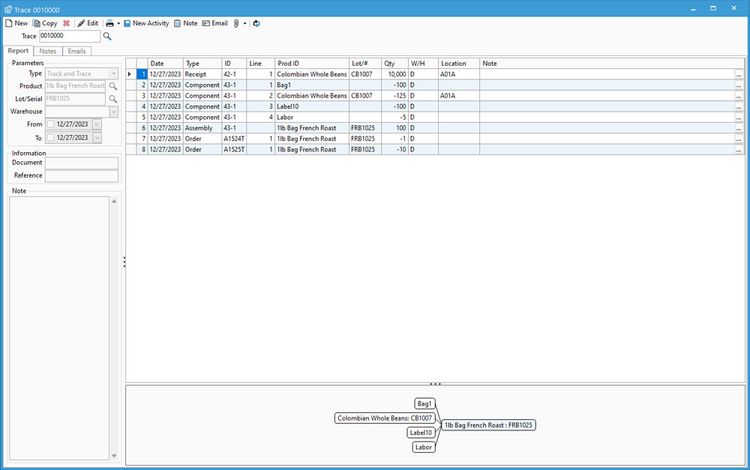
Common Challenges
Here are some of the most common hurdles food distribution systems can help you overcome:
- Inefficient Route Planning: Deliveries with suboptimal routing can lead to increased fuel costs and delays, which could spoil food products. Advanced routing can optimize delivery routes to speed up delivery times, reduce costs, and ensure products arrive fresh.
- Costly Operations: Rising fuel costs, inefficient storage, and waste from spoilage can contribute to higher costs. Food distribution software can help reduce waste through strong route planning and inventory management.
- Temperature and Quality Control: Harmful bacteria can multiply when food isn’t in a temperature-controlled environment. Temperature and quality control in your food distribution system prevent bacterial growth and ensure food safety.
- Traceability and Compliance: Food distribution involves handling many products that can directly impact consumer health. Food distribution software ensures you comply with several regulatory bodies, such as the Food Safety Modernization Act. Having software that traces your products back to their origin and has preventative measures can help reduce the risk of contamination and foodborne illness outbreaks.
Pricing
Food distribution software prices vary, from products like Acctivate, which offers a subscription-based model starting at $400 per month, to NetSuite, which ranges from $3,000 to $8,000 per month. Some general yearly cost ranges are:
- Low-Tier: $15,000-$40,000 per year
- Mid-Tier: $40,000-$100,000 per year
- High-Tier: $150,000+ per year
Whichever system you choose, you’ll likely need to contact the developer for a custom quote. The pricing will vary depending on your business size, industry, additional modules needed, training requirements, and ongoing support and maintenance. The table below provides a general idea of what pricing could look like, but keep in mind that these are subscription estimates per month; you’ll still need to pay an initial set-up fee.
| Software | Pricing Model | Subscription Fees |
|---|---|---|
| NetSuite | Subscription | $3,000 - $8,500/month |
| Sage X3 | Subscription | $2,000 - $5,000/month |
| NECS Entrée | Subscription | N/A |
| Acctivate | Subscription | $5,000 - $14,000/year |
| Food Connex | Subscription | $10,000 - $14,000/year |
| Maritech | Subscription | N/A |
| Northstar WMS | Subscription | Starts at $1,000/month |
| Deacom | Subscription | N/A |
| WholesaleWare | Subscription | Starts at $15,000/year |





























































